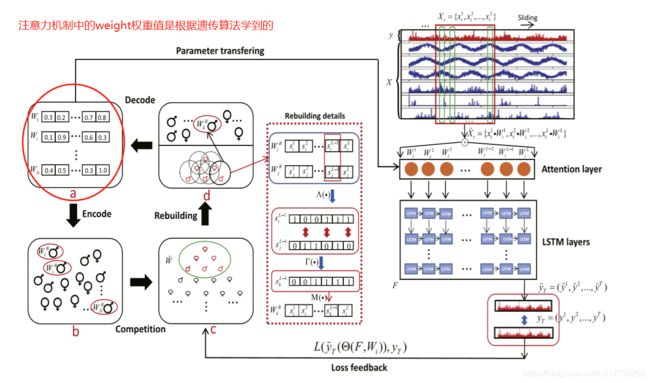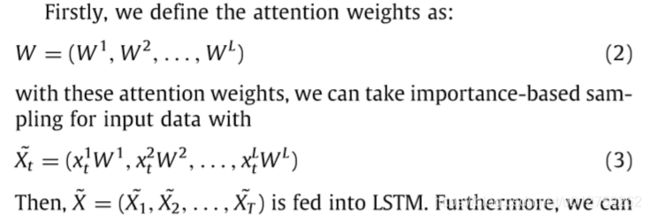- 文献阅读 250222-A Robust Causal Machine Learning Approach
ZzYH22
笔记
InferringHeterogeneousTreatmentEffectsofCrashesonHighwayTraffic:ADoublyRobustCausalMachineLearningApproach来自##Intro:研究问题:高速公路交通事故对交通系统和经济都产生了相当大的影响。在这种情况下,准确可靠的应急响应对于有效的交通管理至关重要。但是,车祸对交通状态的影响因不同因素而异,并
- 文献阅读(part2)--Towards K-means-friendly spaces Simultaneous deep learning and clustering
GUI Research Group
机器学习python深度聚类
学习笔记,仅供参考文章目录AbstractIntroductionBackgroundandRelatedWorksProposedFormulationOptimizationProcedureInitializationviaLayer-wisePre-Training(通过分层预训练进行初始化)AlternatingStochasticOptimizationExperiments合成数据演
- 【文献阅读分享】PAP-REC:个性化自动提示生成框架✨
Sheakan
推荐系统论文阅读总结人工智能推荐系统
标题期刊年份PAP-REC:PersonalizedAutomaticPromptforRecommendationLanguageModelACMTransactionsonInformationSystems(TOIS)2024研究背景在信息爆炸的时代,我们每天都要面对海量的数据和选择,这时候推荐系统就像我们的智能小助手,帮助我们在茫茫信息海洋中找到真正需要的资源。但是,传统的推荐系统模型大多
- 《Semantic communications - Principles and challenges》语义通信文献阅读与分析总结
snow每天都要好好学习
深度学习深度学习
《语义通信:原理与挑战》文献详细总结1.语义通信的概念语义通信是一种超越传统香农通信范式的全新通信模式,它关注的是信息意义的传递,而不仅仅是数据本身的准确传输。传统通信强调比特级别的准确性,而语义通信更强调信息对接收方执行特定任务的有效性。这种模式被认为是第六代(6G)无线网络的核心技术之一,能够支持包括智能交通、智能监控、视频会议、增强现实(AR)和虚拟现实(VR)在内的多种智能应用。在语义通信
- 文献管理工具Zotero超详细教程,包含各个方面
程序猿000001号
论文阅读
1、为什么要使用Zotero上面两种方式对于后期进行写作,文献查找以及文献引用的都不方便,使用文献管理软件具有以下优点:下面是目前几款常见的文献阅读软件的对比:通过上面对比,可以看出Zotero在文献管理软件中具有一定的优势,下面介绍Zotero软件的使用。2、如何将论文导入Zotero2.1通过浏览器插件在浏览器中安装zotero插件后,在浏览器右上角就能够出现一个文件夹图标,此时就可以点击该文
- Python——基于ERA5数据的饱和水汽压差(VPD)批量计算(Clausius-Clapeyron 克劳修斯-克拉伯龙关系)
雨宫芳树
算法pythonarcgis数据分析开发语言
一、前言之前我发布过基于CRU数据和Goff-Gratch公式计算VPD的博客,见下方:基于CRU数据计算VPD的博客但是,CRU数据的分辨率还是较为粗糙(0.5°×0.5°),而ERA5land数据集分辨率能很好地满足我的需求(0.1°×0.1°)。但是,ERA5land数据集并不提供水汽压和湿度变量供于下载,这导致利用Goff-Gratch公式很难进行计算。结合近期文献阅读和整理,这里提供另一
- [特殊字符]文献阅读分享:《负面情绪更吸睛?利用大型语言模型重构新闻推荐系统中的情感框架》
Sheakan
推荐系统论文阅读总结语言模型重构人工智能
论文背景在当今信息爆炸的时代,新闻推荐系统(NewsRecommenderSystems,NRS)成为用户获取新闻的重要工具。然而,新闻内容的呈现方式(即新闻框架)对用户的参与度和付费意愿有着深远的影响。随着人工智能技术的发展,大型语言模型(LLMs)逐渐被引入新闻生产过程,为新闻框架的重构提供了新的可能性。本文通过实验研究,探讨了基于LLM的情感框架重构对用户情感、参与度和付费意愿的影响。相关工
- 想提升英文文献阅读速度?有哪些实用方法?
paixiaoxin
科研方法文献工具人工智能科研研究生文献管理文献阅读文献翻译scholaread
在科研的道路上,筛选文献就像是大海捞针,找对了方法,就能快速锁定那些有价值的信息。尤其是在实验方向尚未确定时,如何从海量文献中筛选出“金子”,就显得尤为重要。关键的第一步:精准筛选当你面对一堆英文文献时,首先得明白,不是每一篇文献都值得你细读。这时候,筛选的技巧就显得至关重要。以下是如何快速而精准地进行筛选:快速阅读技巧:先看摘要和结论:这是最快速了解文章核心的方法。如果这两部分都看不懂或者不感兴
- 研究生师兄谈SCI论文写作心得
华大基因学院
即将毕业的高产博士师兄(博士在读期间累计发表SCI论文11篇,其中第一作者或通讯作者论文10篇),受学院委托介绍一下论文写作经验,希望能对大家更快、更轻松发表学术论文提供些许帮助。一、文献阅读在开展课题前,阅读文献是一个不可或缺的环节,只有充分了解你要做的课题,才能得心应手地设计课题,进而快速的围绕计划开展研究、准备数据,方便后期撰写论文。实际上,很多小伙伴常常花费大量时间看各种文献,但还是往往不
- Pytorch学习记录-接近人类水平的GEC(使用混合机器翻译模型)
我的昵称违规了
五月第二周要结束了,接下来的三个月主要是文献阅读,准备8、9月的开题报告,技术类的文献集中在GEC和Textmaching的应用方面,读完之后找demo复现,然后应用。理论方面的论文也都是英文的8.NearHuman-LevelPerformanceinGrammaticalErrorCorrectionwithHybridMachineTranslation昨天一天没看论文,发现我文献阅读速度太
- 文献阅读(42)——使用深度学习在眼底照中检测糖网并分类(综述)
柚子味的羊
文献阅读深度学习分类人工智能
使用深度学习在眼底照中检测糖网并分类(综述)Deeplearningfordiabeticretinopathydetectionandclassificationbasedonfundusimages:AreviewIF=6.698/Q1文章目录使用深度学习在眼底照中检测糖网并分类(综述)先验知识/知识拓展文章结构文章结果1.introduction方法1.眼底图像一般的分析pipeline2.
- 机器学习第二十五周周报 ConvLSTM
沽漓酒江
机器学习人工智能
文章目录week25ConvLSTM摘要Abstract一、李宏毅机器学习二、文献阅读1.题目2.abstract3.网络架构3.1降水预报问题的建模3.2ConvolutionalLSTM3.3编码-预测结构4.文献解读4.1Introduction4.2创新点4.3实验过程4.3.1Moving-MNISTDataset4.3.2雷达回波数据集4.4结论三、基于pytorch实现ConvLST
- 机器学习第二十八周周报 PINNs2
沽漓酒江
机器学习人工智能
文章目录week28PINNs2摘要Abstract一、Lipschitz条件二、文献阅读1.题目数据驱动的偏微分方程2.连续时间模型3.离散时间模型4.结论三、CLSTM1.任务要求2.实验结果3.实验代码3.1模型构建3.2训练过程代码小结参考文献week28PINNs2摘要本文主要讨论PINN。本文简要介绍了Lipschitz条件。其次本文展示了题为Physics-informedneura
- 文献阅读:金鱼端脑细胞类型图谱揭示了空间结构和细胞类型进化的多样性
程序员
:::block-1文献介绍文献题目Atelencephaloncelltypeatlasforgoldfishrevealsdiversityintheevolutionofspatialstructureandcelltypes\研究团队AmitZeisel(以色列理工学院)、RonenSegev(本·古里安大学)\发表时间2023-11-01\发表期刊ScienceAdvances\影响因子
- 文献阅读-nomogram文章(七)
cHarden13
题目:DevelopmentandValidationofaRadiomicsNomogramforPreoperativePredictionofLymphNodeMetastasisinColorectalCancerlogistic回归;放射组学;结直肠癌;淋巴结转移ref:医学方:临床医生的逆袭:深入解析临床研究预测类文章思路,带你成为科研“大牛”!一.纳入病人纳入2007.2-2010.
- 【思维导图认证班】戴兰第四幅思维导图作业-日程规划
一为宝贝
我没有选择一日的时间来进行规划,而是以一个市级课题的完成来规划具体的步骤,因为这段时间都在集中做课题,没有安排其他的事情,所以没安排具体的时间。步骤分四部分:准备、撰写、查重和提交。准备又分为文献阅读准备和人员访谈准备;撰写分为结题报告、成果鉴定、成果要报。查重为知网,小于30%。提交分电子版和纸质版。心得:撰写前梳理整个课题的环节,撰写中边阅读文献边记录自己撰写的思路,撰写后按照思维导图傻瓜式准
- 200320复盘
呼噜噜_77b5
上午上课,完成皮肤病学习。下午文献阅读,洗了个澡,然后完成单词,听力,阅读,口语。晚上部分完成老板任务。总得来讲,时间大部分利用了,效率和质量有待提高。
- 文献阅读:Mamba: Linear-Time Sequence Modeling with Selective State Spaces
Espresso Macchiato
文献阅读MambaTransformerSSSMS6SSM
文献阅读:Mamba:Linear-TimeSequenceModelingwithSelectiveStateSpaces1.文章简介2.方法介绍1.StateSpaceModels2.SelectiveStateSpaceModels3.实验考察&结论1.简单问题上的验证2.实际场景效果1.语言模型2.DNA模型3.语音模型3.细节考察1.速度和内存考察2.消融实验4.结论&思考文献链接:ht
- 2019-7-20晨间日记
风雨兼程_007
今天是什么日子起床:0800就寝:2300天气:晴心情:美纪念日:无叫我起床的不是闹钟是梦想年度目标及关键点:结束一年的学校生活,重整行装再出发!本月重要成果:文献阅读报告选对方向今日三只青蛙/番茄钟看望阿姨,学习人家的好习惯看看优秀的人的家庭是怎么样的从中学习,思考人生成功日志-记录三五件有收获的事务给儿子修玩具枪,让其有自豪感陪娃学习,共同见证人家的成长信任感,信赖这东西靠培养财务检视看清楚自
- Pytorch学习记录-GEC语法纠错
我的昵称违规了
Pytorch学习记录-GEC语法纠错01五月第一周要结束了,接下来的三个月主要是文献阅读,准备8、9月的开题报告,技术类的文献集中在GEC和Textmaching的应用方面,读完之后找demo复现,然后应用。理论方面的论文也都是英文的,国内这块做的真的不行啊……学习计划GEC概念AlibabaatIJCNLP-2017Task1:EmbeddingGrammaticalFeaturesintoL
- scanpy 教程 1:预处理和聚类 3k PBMCs
Tiger Z
程序人生
「写在前面」学习一个软件最好的方法就是啃它的官方文档。本着自己学习、分享他人的态度,分享官方文档的中文教程。软件可能随时更新,建议配合官方文档一起阅读。推荐先按顺序阅读往期内容:文献篇:1.文献阅读:SCANPY:大规模单细胞基因表达数据分析2.文献阅读:scverse项目为单细胞组学数据分析提供了计算生态系统目录1预处理2主成分分析3计算邻域图4嵌入邻域图5对邻域图进行聚类6寻找标记基因官网教程
- 文献阅读:金鱼端脑细胞类型图谱揭示了空间结构和细胞类型进化的多样性
Tiger Z
程序人生
文献介绍「文献题目」Atelencephaloncelltypeatlasforgoldfishrevealsdiversityintheevolutionofspatialstructureandcelltypes「研究团队」AmitZeisel(以色列理工学院)、RonenSegev(本·古里安大学)「发表时间」2023-11-01「发表期刊」ScienceAdvances「影响因子」13.6
- 文献阅读02-2022-12-15
不学无术吗
题目:recentadvancesinRNAstructurome摘要:RNAstructuresareessentialtosupportRNAfunctionsandregulationinvariousbiologicalprocesses.Recently,arangeofnoveltechnologieshavebeendevelopedtodecodegenome-wideRNAstr
- 2024.2.4周报
Nyctophiliaa
人工智能深度学习
目录摘要一、文献阅读1、题目2、摘要3、模型架构4、文献解读一、Introduction二、实验三、结论二、PINN一、PINN比传统数值方法有哪些优势二、PINN方法三、正问题与反问题总结摘要本周我阅读了一篇题目为DeepResidualLearningforImageRecognition的文献,文章的贡献是作者提出了残差网络的思想,且证明了更深层的残差网络具有比VGG网络更低的复杂度和更高的
- 一种通过增强的面部边界实现精确面部表示的多级人脸超分辨率
qq_43314576
人工智能机器学习深度学习
提示:文章写完后,目录可以自动生成,如何生成可参考右边的帮助文档文章目录摘要Abstract文献阅读:一种通过增强的面部边界实现精确面部表示的多级人脸超分辨率二、使用步骤1、研究背景2、方法提出3、相关方法3.1、FSR网络结构3.2、多阶段FSR网络结构4、实验工作5、方法比较LSTM代码学习2.1、什么是LSTM2.2、LSTM的处理过程2.3、LSTM代码分析总结摘要本周主要阅读了2020C
- 基于场景文字知识挖掘的细粒度图像识别算法
qq_43314576
算法深度学习人工智能
提示:文章写完后,目录可以自动生成,如何生成可参考右边的帮助文档文章目录摘要Abstract文献阅读:基于场景文字知识挖掘的细粒度图像识别算法1、研究背景2、方法提出方法模块3、试验4、文章贡献二、RNN代码学习2.1、什么是RNN2.2、RNN的处理过程2.3、RNN简单代码实现总结摘要本周主要阅读了2022CVPR的文章,基于场景文字知识挖掘的细粒度图像识别算法,该论文提出了一种通过挖掘场景文
- 2019-05-06文献阅读记录
一行白鹭上青天
2019-05-06阅读记录:题目:基于RS和GIS的桓仁县乡村聚落景观格局分析(2005年发表)期刊:测绘与空间地理信息Geomatics&SpatialInformationTechnology作者:于淼;李建东摘要:运用RS和GIS技术以及景观分析方法,以辽东山区桓仁县典型的6个乡镇乡村聚落为研究对象,选取乡村聚落斑块数、斑块面积、斑块密度、平均斑块面积、面积加权平均斑块分维数等5个景观指数
- 对于CNN的文献阅读和识别手写数字的复现
白小李
深度学习cnn神经网络
摘要一、文献阅读1、题目2、摘要3、引言4、CNN模型结构5、实验过程6、同GS算法的对比二、CNN识别手写数字1、两个性质2、图像卷积总结摘要在论文方面阅读了基于CNN网络对于大气湍流相位的提取,对CNN的结构网络和运行原理进行了学习,对CNN识别手写数字方面展开了编码,采用MINST数据集进行训练模型,并计划通过窗口就行可视化展现。Ireadthepaperonphaseextractiono
- 每日早晚都读书1000/101-专业文献阅读|《外国建筑历史图说》刘松茯教授编著 通过阅读 专业书籍 获得多元思维的处世之法
李廿
历史发展到今天,古代、近现代和当代,不同的时代反映了不同的建筑观。刘松茯教授作为建筑教育学方面的一名资深中国学者,撰写这本《外国建筑历史图说》,并按照古代、近现代和当代三个不同时期对外国建筑史进行多方位、多角度、多层面的归纳和解读。1,首先,建筑是一种时代气息的表达。建筑与时代的关联十分密切,脱离了时代,建筑的生命力也就枯竭了。农业社会,建筑是手工艺产品:工业社会,建筑是机械化产品:信息社会,建筑
- 【文献阅读笔记】去噪学生网络:DeSTSeg
迎着黎明那道光
文献阅读笔记视觉异常检测笔记异常检测视觉检测深度学习
2023CVPR领域:异常检测目标:图像输入数据文章目录1、模型2、方法3、实验4、引用5、想法1、模型模型分为三个模块,包括教师网络、去噪学生网络和分割网络。分为两个阶段进行训练,第一阶段训练去噪学生网络,第二阶段训练分割网络。2、方法去噪学生网络,主要解决的是异常过度泛化的问题,利用编码器-解码器架构实现去噪。在第一个阶段将合成异常图像输入,训练去噪学生网络输出无异常图像。使用合成异常图像的目
- 如何用ruby来写hadoop的mapreduce并生成jar包
wudixiaotie
mapreduce
ruby来写hadoop的mapreduce,我用的方法是rubydoop。怎么配置环境呢:
1.安装rvm:
不说了 网上有
2.安装ruby:
由于我以前是做ruby的,所以习惯性的先安装了ruby,起码调试起来比jruby快多了。
3.安装jruby:
rvm install jruby然后等待安
- java编程思想 -- 访问控制权限
百合不是茶
java访问控制权限单例模式
访问权限是java中一个比较中要的知识点,它规定者什么方法可以访问,什么不可以访问
一:包访问权限;
自定义包:
package com.wj.control;
//包
public class Demo {
//定义一个无参的方法
public void DemoPackage(){
System.out.println("调用
- [生物与医学]请审慎食用小龙虾
comsci
生物
现在的餐馆里面出售的小龙虾,有一些是在野外捕捉的,这些小龙虾身体里面可能带有某些病毒和细菌,人食用以后可能会导致一些疾病,严重的甚至会死亡.....
所以,参加聚餐的时候,最好不要点小龙虾...就吃养殖的猪肉,牛肉,羊肉和鱼,等动物蛋白质
- org.apache.jasper.JasperException: Unable to compile class for JSP:
商人shang
maven2.2jdk1.8
环境: jdk1.8 maven tomcat7-maven-plugin 2.0
原因: tomcat7-maven-plugin 2.0 不知吃 jdk 1.8,换成 tomcat7-maven-plugin 2.2就行,即
<plugin>
- 你的垃圾你处理掉了吗?GC
oloz
GC
前序:本人菜鸟,此文研究学习来自网络,各位牛牛多指教
1.垃圾收集算法的核心思想
Java语言建立了垃圾收集机制,用以跟踪正在使用的对象和发现并回收不再使用(引用)的对象。该机制可以有效防范动态内存分配中可能发生的两个危险:因内存垃圾过多而引发的内存耗尽,以及不恰当的内存释放所造成的内存非法引用。
垃圾收集算法的核心思想是:对虚拟机可用内存空间,即堆空间中的对象进行识别
- shiro 和 SESSSION
杨白白
shiro
shiro 在web项目里默认使用的是web容器提供的session,也就是说shiro使用的session是web容器产生的,并不是自己产生的,在用于非web环境时可用其他来源代替。在web工程启动的时候它就和容器绑定在了一起,这是通过web.xml里面的shiroFilter实现的。通过session.getSession()方法会在浏览器cokkice产生JESSIONID,当关闭浏览器,此
- 移动互联网终端 淘宝客如何实现盈利
小桔子
移動客戶端淘客淘寶App
2012年淘宝联盟平台为站长和淘宝客带来的分成收入突破30亿元,同比增长100%。而来自移动端的分成达1亿元,其中美丽说、蘑菇街、果库、口袋购物等App运营商分成近5000万元。 可以看出,虽然目前阶段PC端对于淘客而言仍旧是盈利的大头,但移动端已经呈现出爆发之势。而且这个势头将随着智能终端(手机,平板)的加速普及而更加迅猛
- wordpress小工具制作
aichenglong
wordpress小工具
wordpress 使用侧边栏的小工具,很方便调整页面结构
小工具的制作过程
1 在自己的主题文件中新建一个文件夹(如widget),在文件夹中创建一个php(AWP_posts-category.php)
小工具是一个类,想侧边栏一样,还得使用代码注册,他才可以再后台使用,基本的代码一层不变
<?php
class AWP_Post_Category extends WP_Wi
- JS微信分享
AILIKES
js
// 所有功能必须包含在 WeixinApi.ready 中进行
WeixinApi.ready(function(Api) {
// 微信分享的数据
var wxData = {
&nb
- 封装探讨
百合不是茶
JAVA面向对象 封装
//封装 属性 方法 将某些东西包装在一起,通过创建对象或使用静态的方法来调用,称为封装;封装其实就是有选择性地公开或隐藏某些信息,它解决了数据的安全性问题,增加代码的可读性和可维护性
在 Aname类中申明三个属性,将其封装在一个类中:通过对象来调用
例如 1:
//属性 将其设为私有
姓名 name 可以公开
- jquery radio/checkbox change事件不能触发的问题
bijian1013
JavaScriptjquery
我想让radio来控制当前我选择的是机动车还是特种车,如下所示:
<html>
<head>
<script src="http://ajax.googleapis.com/ajax/libs/jquery/1.7.1/jquery.min.js" type="text/javascript"><
- AngularJS中安全性措施
bijian1013
JavaScriptAngularJS安全性XSRFJSON漏洞
在使用web应用中,安全性是应该首要考虑的一个问题。AngularJS提供了一些辅助机制,用来防护来自两个常见攻击方向的网络攻击。
一.JSON漏洞
当使用一个GET请求获取JSON数组信息的时候(尤其是当这一信息非常敏感,
- [Maven学习笔记九]Maven发布web项目
bit1129
maven
基于Maven的web项目的标准项目结构
user-project
user-core
user-service
user-web
src
- 【Hive七】Hive用户自定义聚合函数(UDAF)
bit1129
hive
用户自定义聚合函数,用户提供的多个入参通过聚合计算(求和、求最大值、求最小值)得到一个聚合计算结果的函数。
问题:UDF也可以提供输入多个参数然后输出一个结果的运算,比如加法运算add(3,5),add这个UDF需要实现UDF的evaluate方法,那么UDF和UDAF的实质分别究竟是什么?
Double evaluate(Double a, Double b)
- 通过 nginx-lua 给 Nginx 增加 OAuth 支持
ronin47
前言:我们使用Nginx的Lua中间件建立了OAuth2认证和授权层。如果你也有此打算,阅读下面的文档,实现自动化并获得收益。SeatGeek 在过去几年中取得了发展,我们已经积累了不少针对各种任务的不同管理接口。我们通常为新的展示需求创建新模块,比如我们自己的博客、图表等。我们还定期开发内部工具来处理诸如部署、可视化操作及事件处理等事务。在处理这些事务中,我们使用了几个不同的接口来认证:
&n
- 利用tomcat-redis-session-manager做session同步时自定义类对象属性保存不上的解决方法
bsr1983
session
在利用tomcat-redis-session-manager做session同步时,遇到了在session保存一个自定义对象时,修改该对象中的某个属性,session未进行序列化,属性没有被存储到redis中。 在 tomcat-redis-session-manager的github上有如下说明: Session Change Tracking
As noted in the &qu
- 《代码大全》表驱动法-Table Driven Approach-1
bylijinnan
java算法
关于Table Driven Approach的一篇非常好的文章:
http://www.codeproject.com/Articles/42732/Table-driven-Approach
package com.ljn.base;
import java.util.Random;
public class TableDriven {
public
- Sybase封锁原理
chicony
Sybase
昨天在操作Sybase IQ12.7时意外操作造成了数据库表锁定,不能删除被锁定表数据也不能往其中写入数据。由于着急往该表抽入数据,因此立马着手解决该表的解锁问题。 无奈此前没有接触过Sybase IQ12.7这套数据库产品,加之当时已属于下班时间无法求助于支持人员支持,因此只有借助搜索引擎强大的
- java异常处理机制
CrazyMizzz
java
java异常关键字有以下几个,分别为 try catch final throw throws
他们的定义分别为
try: Opening exception-handling statement.
catch: Captures the exception.
finally: Runs its code before terminating
- hive 数据插入DML语法汇总
daizj
hiveDML数据插入
Hive的数据插入DML语法汇总1、Loading files into tables语法:1) LOAD DATA [LOCAL] INPATH 'filepath' [OVERWRITE] INTO TABLE tablename [PARTITION (partcol1=val1, partcol2=val2 ...)]解释:1)、上面命令执行环境为hive客户端环境下: hive>l
- 工厂设计模式
dcj3sjt126com
设计模式
使用设计模式是促进最佳实践和良好设计的好办法。设计模式可以提供针对常见的编程问题的灵活的解决方案。 工厂模式
工厂模式(Factory)允许你在代码执行时实例化对象。它之所以被称为工厂模式是因为它负责“生产”对象。工厂方法的参数是你要生成的对象对应的类名称。
Example #1 调用工厂方法(带参数)
<?phpclass Example{
- mysql字符串查找函数
dcj3sjt126com
mysql
FIND_IN_SET(str,strlist)
假如字符串str 在由N 子链组成的字符串列表strlist 中,则返回值的范围在1到 N 之间。一个字符串列表就是一个由一些被‘,’符号分开的自链组成的字符串。如果第一个参数是一个常数字符串,而第二个是type SET列,则 FIND_IN_SET() 函数被优化,使用比特计算。如果str不在strlist 或st
- jvm内存管理
easterfly
jvm
一、JVM堆内存的划分
分为年轻代和年老代。年轻代又分为三部分:一个eden,两个survivor。
工作过程是这样的:e区空间满了后,执行minor gc,存活下来的对象放入s0, 对s0仍会进行minor gc,存活下来的的对象放入s1中,对s1同样执行minor gc,依旧存活的对象就放入年老代中;
年老代满了之后会执行major gc,这个是stop the word模式,执行
- CentOS-6.3安装配置JDK-8
gengzg
centos
JAVA_HOME=/usr/java/jdk1.8.0_45
JRE_HOME=/usr/java/jdk1.8.0_45/jre
PATH=$PATH:$JAVA_HOME/bin:$JRE_HOME/bin
CLASSPATH=.:$JAVA_HOME/lib/dt.jar:$JAVA_HOME/lib/tools.jar:$JRE_HOME/lib
export JAVA_HOME
- 【转】关于web路径的获取方法
huangyc1210
Web路径
假定你的web application 名称为news,你在浏览器中输入请求路径: http://localhost:8080/news/main/list.jsp 则执行下面向行代码后打印出如下结果: 1、 System.out.println(request.getContextPath()); //可返回站点的根路径。也就是项
- php里获取第一个中文首字母并排序
远去的渡口
数据结构PHP
很久没来更新博客了,还是觉得工作需要多总结的好。今天来更新一个自己认为比较有成就的问题吧。 最近在做储值结算,需求里结算首页需要按门店的首字母A-Z排序。我的数据结构原本是这样的:
Array
(
[0] => Array
(
[sid] => 2885842
[recetcstoredpay] =&g
- java内部类
hm4123660
java内部类匿名内部类成员内部类方法内部类
在Java中,可以将一个类定义在另一个类里面或者一个方法里面,这样的类称为内部类。内部类仍然是一个独立的类,在编译之后内部类会被编译成独立的.class文件,但是前面冠以外部类的类名和$符号。内部类可以间接解决多继承问题,可以使用内部类继承一个类,外部类继承一个类,实现多继承。
&nb
- Caused by: java.lang.IncompatibleClassChangeError: class org.hibernate.cfg.Exten
zhb8015
maven pom.xml关于hibernate的配置和异常信息如下,查了好多资料,问题还是没有解决。只知道是包冲突,就是不知道是哪个包....遇到这个问题的分享下是怎么解决的。。
maven pom:
<dependency>
<groupId>org.hibernate</groupId>
<ar
- Spark 性能相关参数配置详解-任务调度篇
Stark_Summer
sparkcachecpu任务调度yarn
随着Spark的逐渐成熟完善, 越来越多的可配置参数被添加到Spark中来, 本文试图通过阐述这其中部分参数的工作原理和配置思路, 和大家一起探讨一下如何根据实际场合对Spark进行配置优化。
由于篇幅较长,所以在这里分篇组织,如果要看最新完整的网页版内容,可以戳这里:http://spark-config.readthedocs.org/,主要是便
- css3滤镜
wangkeheng
htmlcss
经常看到一些网站的底部有一些灰色的图标,鼠标移入的时候会变亮,开始以为是js操作src或者bg呢,搜索了一下,发现了一个更好的方法:通过css3的滤镜方法。
html代码:
<a href='' class='icon'><img src='utv.jpg' /></a>
css代码:
.icon{-webkit-filter: graysc




